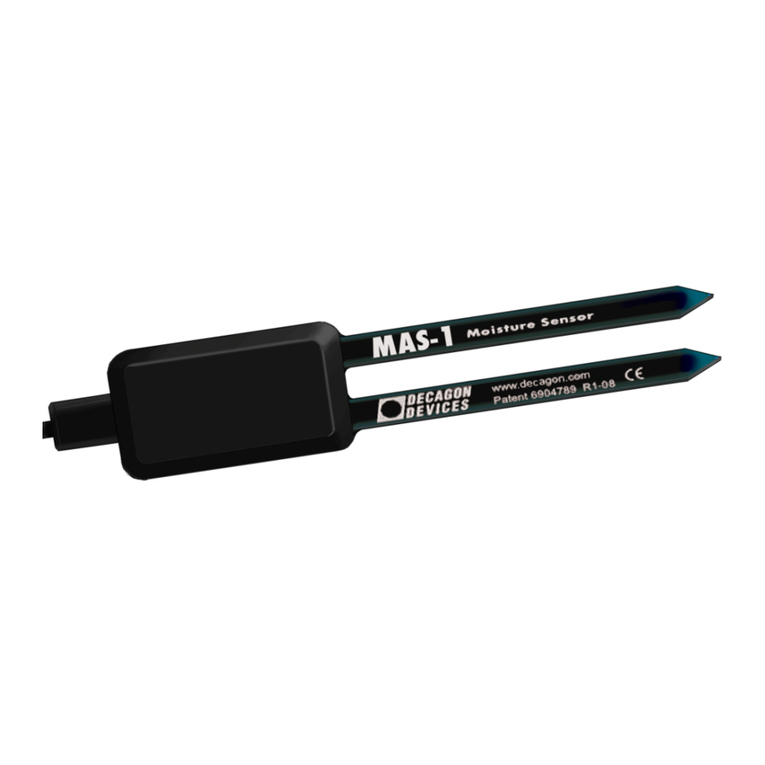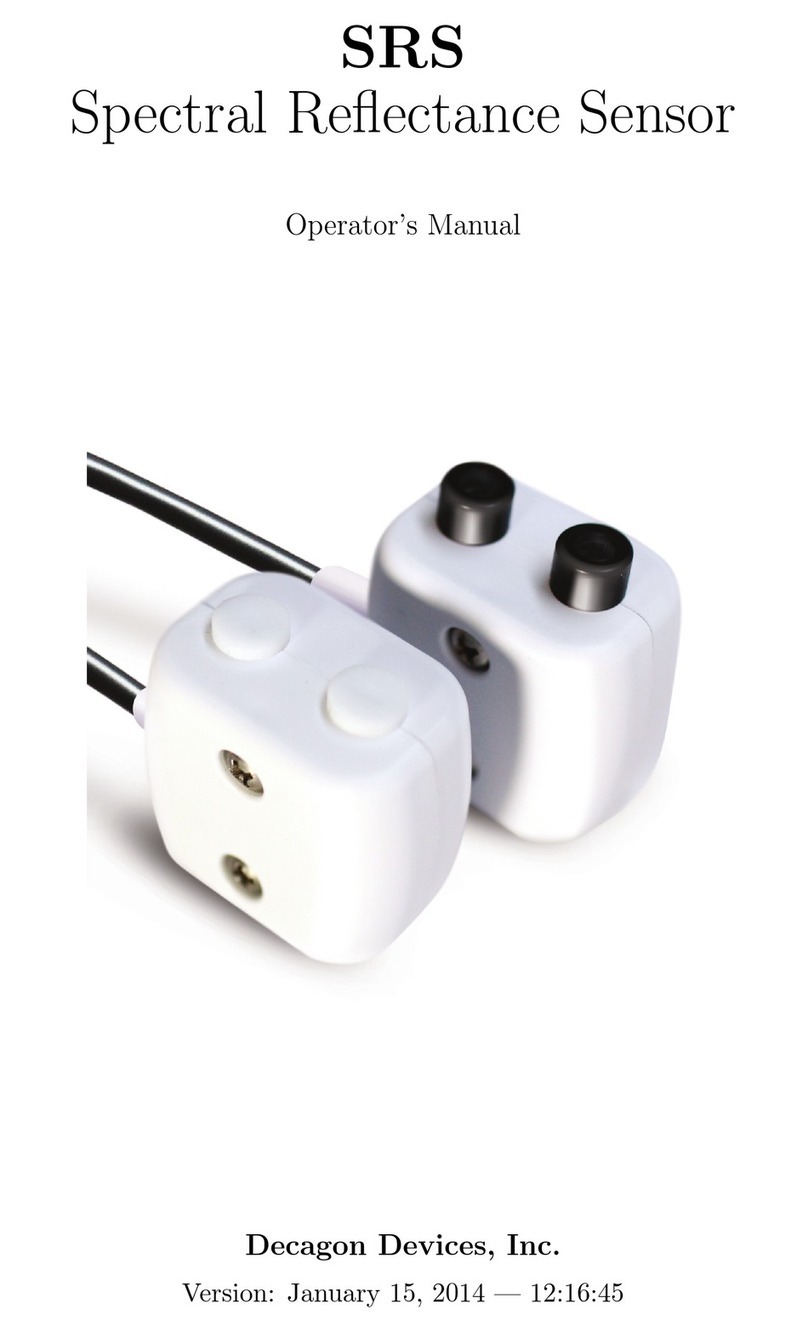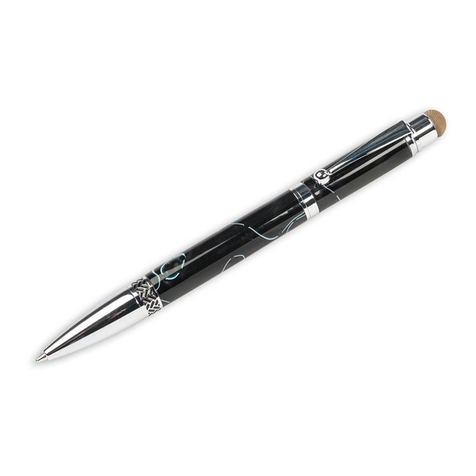Decagon Devices MAS-1 User manual

MAS-1
4-20 mA Soil Moisture Sensor
User Manual
Version 2

Decagon Devices, Inc.
2365 NE Hopkins Court
Pullman WA 99163
(509)332-2756
www.decagon.com
©2011 Decagon Devices, Inc.
All rights reserved.

MAS-1 Soil Moisture Sensor
i
Contents
1. Introduction . . . . . . . . . . . . . . . . . . . 1
Customer Service and Tech Support . . . . .2
Warranty . . . . . . . . . . . . . . . . . . . . . . . . . . .3
Seller’s Liability . . . . . . . . . . . . . . . . . . . . .3
2. About the MAS-1 . . . . . . . . . . . . . . . 4
3. Integrating the MAS-1 . . . . . . . . . . . .5
Wiring . . . . . . . . . . . . . . . . . . . . . . . . . . . . .6
Conventional (PLC) . . . . . . . . . . . . . . . . .6
Non-Conventional . . . . . . . . . . . . . . . . . .6
Testing the Sensor . . . . . . . . . . . . . . . . . . . .9
4. Installing the MAS-1 . . . . . . . . . . . .10
Procedure . . . . . . . . . . . . . . . . . . . . . . . . .10
Orientation . . . . . . . . . . . . . . . . . . . . . . . .11
Removing the Sensor . . . . . . . . . . . . . . . .11
5. Calibration . . . . . . . . . . . . . . . . . . . . .12
Mineral Soils . . . . . . . . . . . . . . . . . . . . . . .12
Potting Soil/Peat . . . . . . . . . . . . . . . . . . . .13
Rock Wool . . . . . . . . . . . . . . . . . . . . . . . .13
6. Troubleshooting . . . . . . . . . . . . . . . . .14
Declaration of Conformity . . . . . . . . . .15
Index . . . . . . . . . . . . . . . . . . . . . . . . . . . .16

MAS-1 Soil Moisture Sensor
1. Introduction
1
1. Introduction
Thank you for choosing the MAS-1 4-20 mA Soil Moisture
Sensor. These innovative sensors will enable you to monitor
soil moisture accurately and affordably with a standard 2-
wire, 4-20 mA analog interface for use with many data
acquisition and control systems. The MAS-1 can not be used
with the standard Decagon data loggers.
Specifications
Electrical
Interface: Standard 4-20 mA, 2-wire analog transmitter
Supply voltage: 10-32 VDC continuous
Output current: 4-20 mA
Overvoltage protection: Yes
Reverse polarity protection: Yes
Settling time: 4 seconds
Wiring: Red wire: (+) supply
Black wire: (-) output
Shield: Not connected
Measurement
Type: Volumetric water content (VWC)
Range: 0-50% VWC typical
Resolution: Depends on current measurement (data
acquisition) device
Accuracy:
± 4 % VWC with factory mineral soil calibration in a
typical mineral soil;
± 1-2% VWC with medium-specific calibration in most
porous medium

MAS-1 Soil Moisture Sensor
1. Introduction
2
Output: 4-20 mA current proportional to VWC
Sensor measurement interval: 1 second
Operating Environment
Temperature: -40 to 50 °C
Physical Properties
Dimensions: 8.9 cm x 1.8 cm x 0.7 cm
Cable: 2 m, 3 wire (22 AWG tinned Red and Black wire, 24
AWG tinned bare wire);
(Custom cable length available upon request)
Customer Service and Tech Support
When contacting us via fax or email, include the following
information: Your MAS-1’s serial number (found on the
white cable label), your name, address, phone and fax
number, and a description of your problem.
Phone
Call Monday - Friday, between 8 a.m. and 5 p.m. PST.
US and Canada (toll-free):
1-800-755-2751
Outside of the US and Canada:
(509) 332-2756
Fax
(509) 332-5158
E-mail
support@decagon.com
.
NOTE
: If you purchased your MAS-1 through a distributor,
please contact them for assistance.

MAS-1 Soil Moisture Sensor
1. Introduction
3
Warranty
The MAS-1 has a one year warranty on parts and labor. It is
activated upon the arrival of the instrument at your location.
Seller’s Liability
Seller warrants new equipment of its own manufacture
against defective workmanship and materials for a period of
one year from date of receipt of equipment (the results of
ordinary wear and tear, neglect, misuse, accident and exces-
sive deterioration due to corrosion from any cause are not to
be considered a defect); but Seller’s liability for defective
parts shall in no event exceed the furnishing of replacement
parts F.O.B. the factory where originally manufactured.
Material and equipment covered hereby which is not manu-
factured by Seller shall be covered only by the warranty of
its manufacturer. Seller shall not be liable to Buyer for loss,
damage or injuries to persons (including death), or to prop-
erty or things of whatsoever kind (including, but not without
limitation, loss of anticipated profits), occasioned by or aris-
ing out of the installation, operation, use, misuse, nonuse,
repair, or replacement of said material and equipment, or out
of the use of any method or process for which the same may
be employed. The use of this equipment constitutes Buyer’s
acceptance of the terms set forth in this warranty. There are
no understandings, representations, or warranties of any
kind, express, implied, statutory or otherwise (including, but
without limitation, the implied warranties of merchantability
and fitness for a particular purpose), not expressly set forth
herein.

MAS-1 Soil Moisture Sensor
2. About the MAS-1
4
2. About the MAS-1
The MAS-1 measures the dielectric constant of the soil in
order to find its volumetric water content. Since the dielec-
tric constant of water is much higher than that of air or soil
minerals, the dielectric constant of the soil is a sensitive
measure of water content. The MAS-1 supplies a 70 MHz
oscillating wave to the sensor prongs that induces an electro-
magnetic field in the medium (soil) surrounding the sensor.
The charging and discharging of the sensor is controlled by
the dielectric of the surrounding soil.
A microprocessor on the MAS-1 measures the charging of
the sensor, and therefore the dielectric constant of the soil
which is related to the water content of the soil. The micro-
processor makes a dielectric measurement and updates the
transmitted current once per second. The transmitted 4-20
mA current can be converted to the water content of the soil
using a simple calibration function.
The MAS-1 was designed to be used with standard 4-20 mA
controllers and monitoring systems. It cannot be used with
Decagon logging systems. For more information about
using Decagon logging systems please contact Decagon’s
customer support representatives.

MAS-1 Soil Moisture Sensor
3. Integrating the MAS-1
5
3. Integrating the MAS-1
A 4-20mA system generally consists of a sensor, a transmit-
ter, a power supply, and a device to read the current being
transmitted through the current loop. The MAS-1 is an inte-
grated sensor and 4-20mA transmitter. When the MAS-1 is
powered by the Power Supply, it transmits a current though
the loop that is proportional to the soil dielectric permittivity
and therefore the soil volumetric water content. In Figure
1, the current loop is shown by the dotted line labeled I=4-
20mA. The arrows indicate the direction of the current.
Figure 1 - 4-20mA current loop diagram
The MAS-1 uses a microcontroller to regulate the interval at
which it takes measurements. It takes one second from the
time it is powered up to take its first measurement and trans-
mit current though the loop. The trasnmitted current will
reach a stable value within four seconds of power up. After
the initial four second startup, measurements are taken every
one second, while the current in the loop is continuously
maintained. Since the measurement intervals are controlled

MAS-1 Soil Moisture Sensor
3. Integrating the MAS-1
6
by the MAS-1 itself, there is no need to pulse the excitation
voltage. A constant supply voltage should be applied in
order for the MAS-1 to function as it is designed.
Wiring
Conventional (PLC)
A Programmable Logic Controller (PLC) is typically used to
read the current transmitted from the MAS-1. The red wire
(see Figure 2) of the MAS-1 is connected to a voltage output
terminal that is able to supply 10-32 VDC. The black wire is
connected to an input terminal that is capable of accepting a
current input ranging from 4 mA to 20 mA.
Figure 2 - Typical wiring connection
Non-Conventional
When using a device, such as a data logger, that does not
have an input capable of measuring current, a pickoff resis-
tor can be used as shown in Figure 3. Assuming that the Sin-
gle Ended Input has an input impedance, or resistance, much
larger that of R
Volt
, then all of the current in the 4-20 mA
loop passes through R
Volt
. If the data logger can measure

MAS-1 Soil Moisture Sensor
3. Integrating the MAS-1
7
the voltage drop over the R
Volt
, then the current can be cal-
culated as
I = V
measured
/ R
Volt
(1)
Where I (mA) is the 4-20 mA current, R
Volt
(ohms) is the
resistance of the pickoff resistor, and V
measured
(mV) is the
voltage drop over R
Volt
.
Figure 3 - Wiring connection for devices without current
inputs
The optional 100uF capacitor shown in parallel with the
RVolt
reduces measurement noise. It should have a voltage rating
higher than the largest supply voltage and be sure to observe
correct polarity.
The value of R
Volt
is limited by the amount of impedance
that the MAS-1 circuitry can drive current through. The val-
ues in Table 1 represent the maximum load that the MAS-1
can drive at the given supply voltage. Equation (2) was
derived from the values in Table 1, which were obtained
through direct measurement. V
in
represents the supply volt-
age to the MAS-1, which ranges from 10-32 VDC. R
Volt Max
Other manuals for MAS-1
1
Table of contents
Other Decagon Devices Accessories manuals
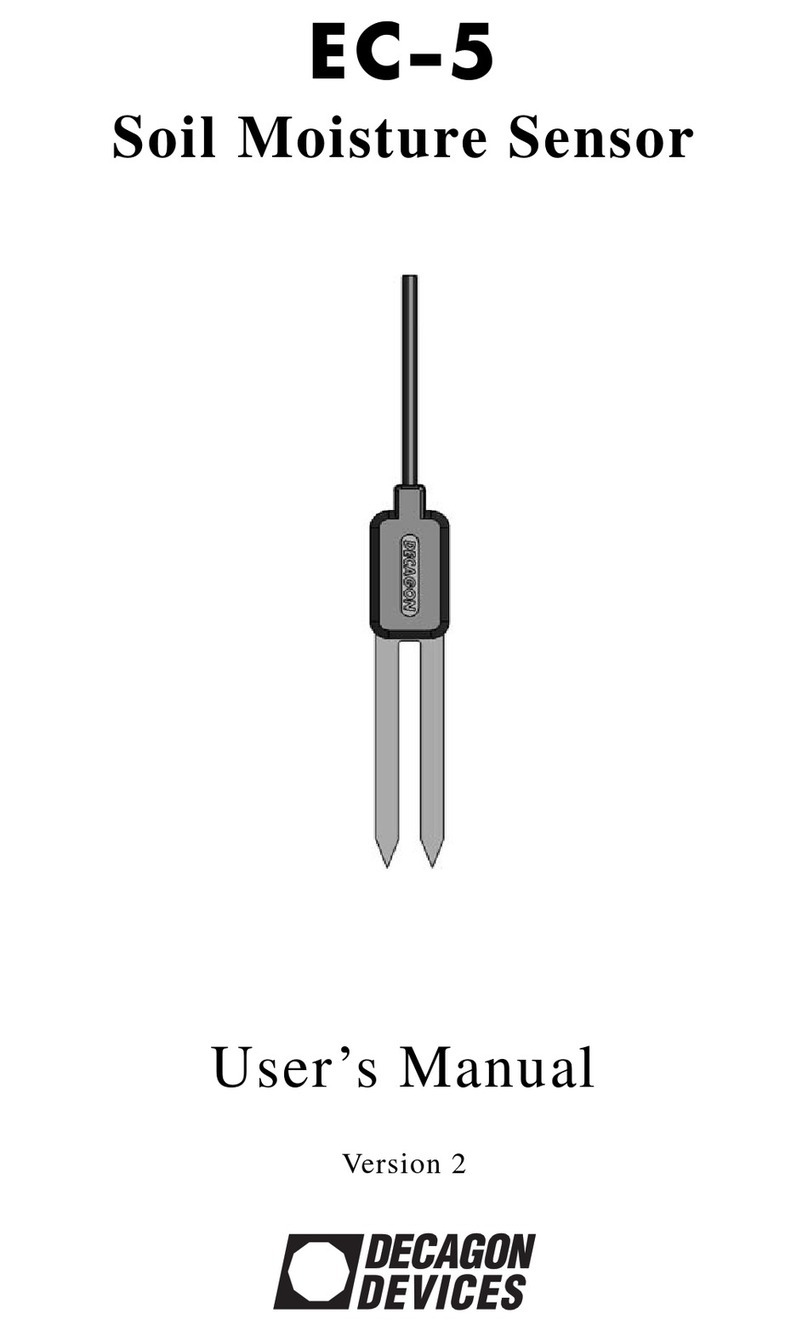
Decagon Devices
Decagon Devices EC-5 User manual
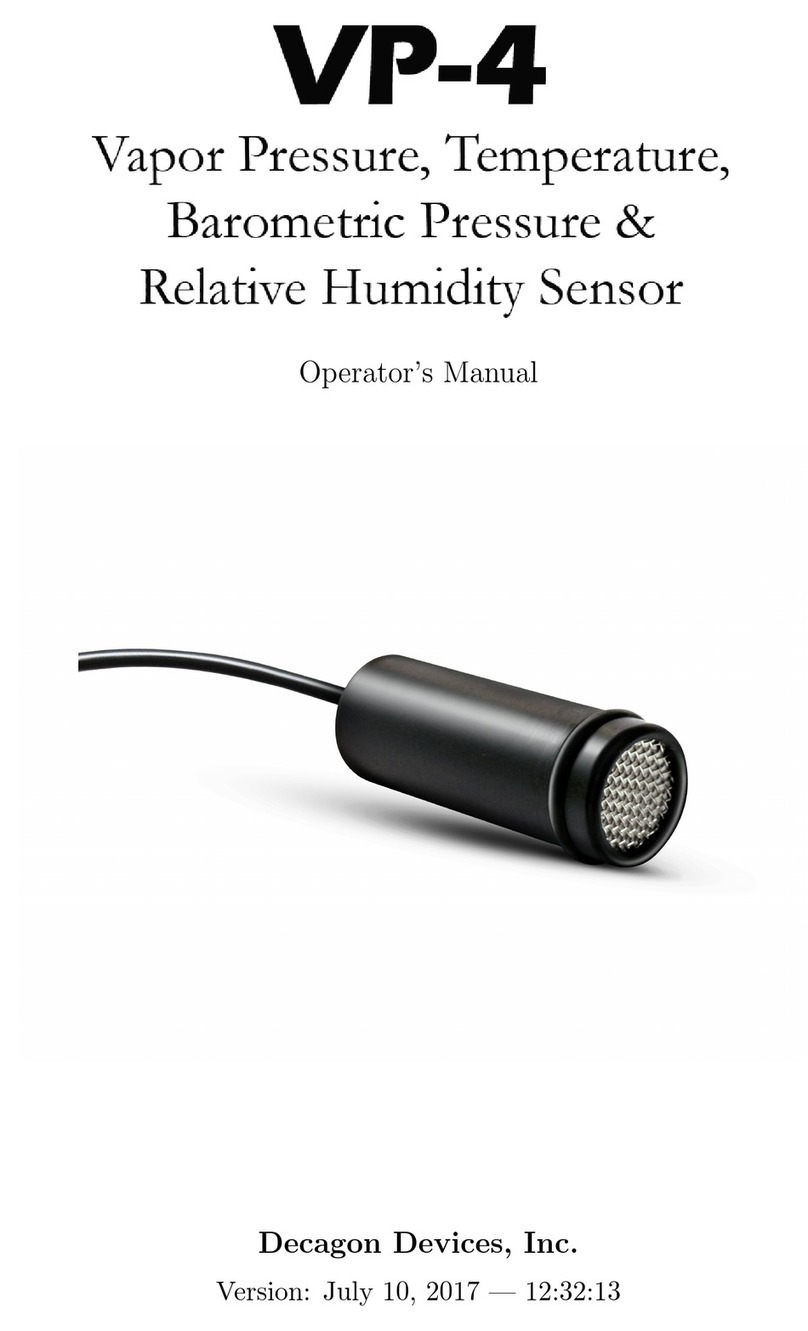
Decagon Devices
Decagon Devices VP-4 User manual
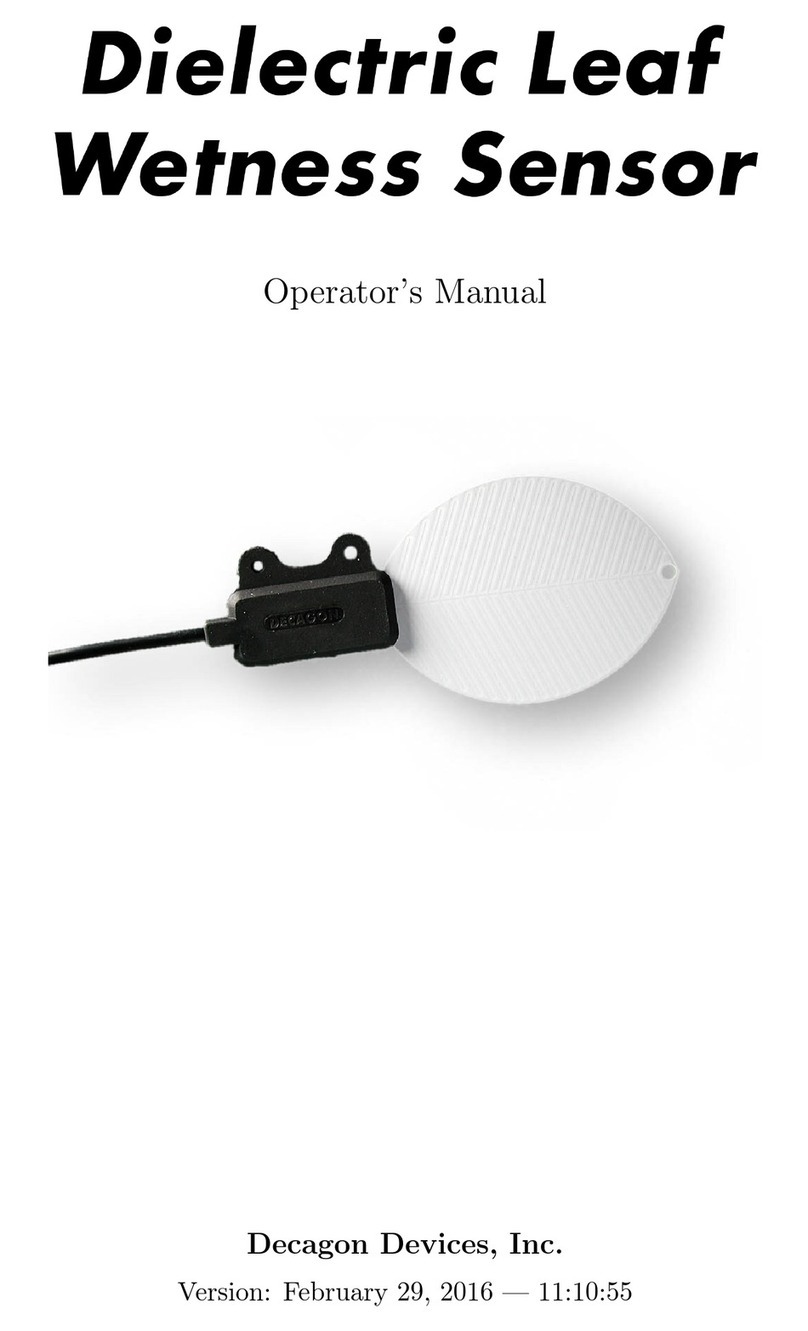
Decagon Devices
Decagon Devices Dielectric Leaf Wetness Sensor Owner's manual
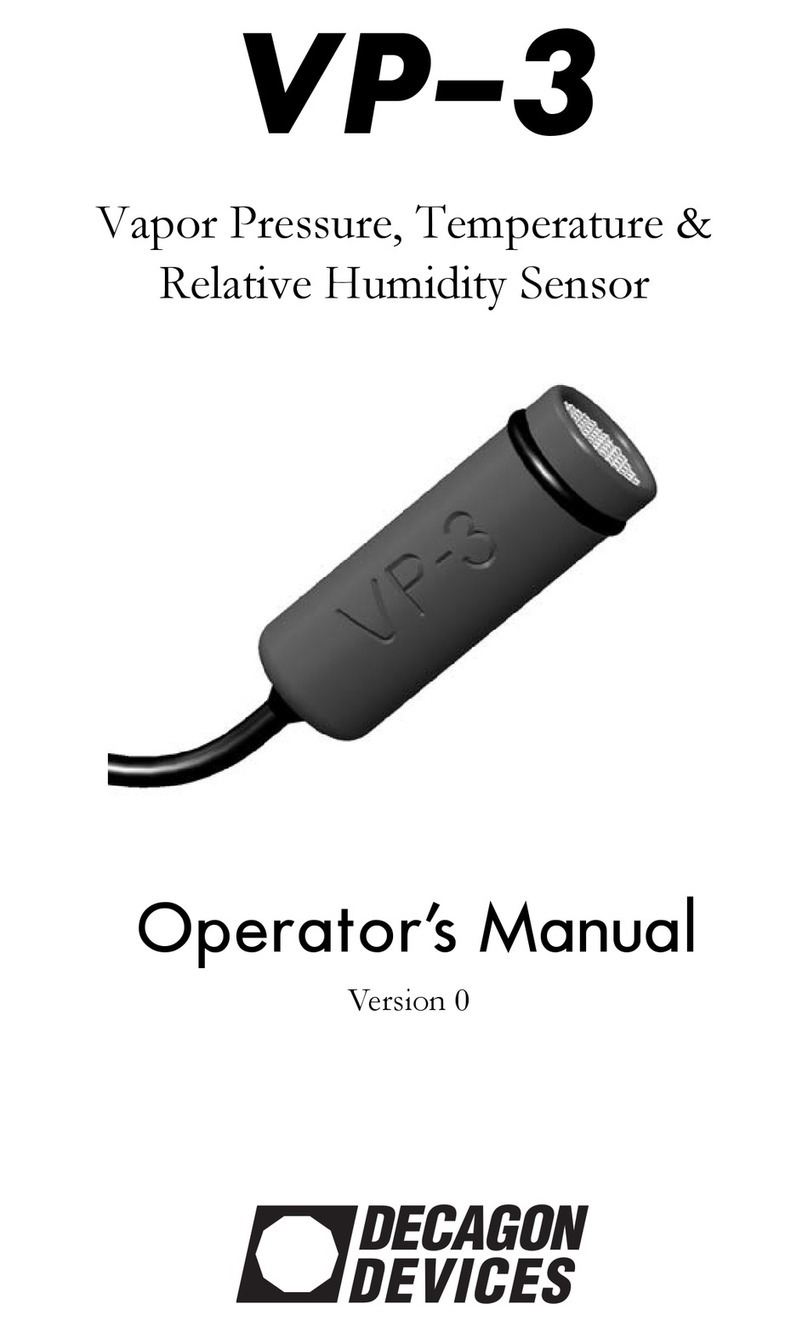
Decagon Devices
Decagon Devices VP-3 User manual

Decagon Devices
Decagon Devices ECH2O EA-10 Assembly Instructions

Decagon Devices
Decagon Devices 5TE User manual
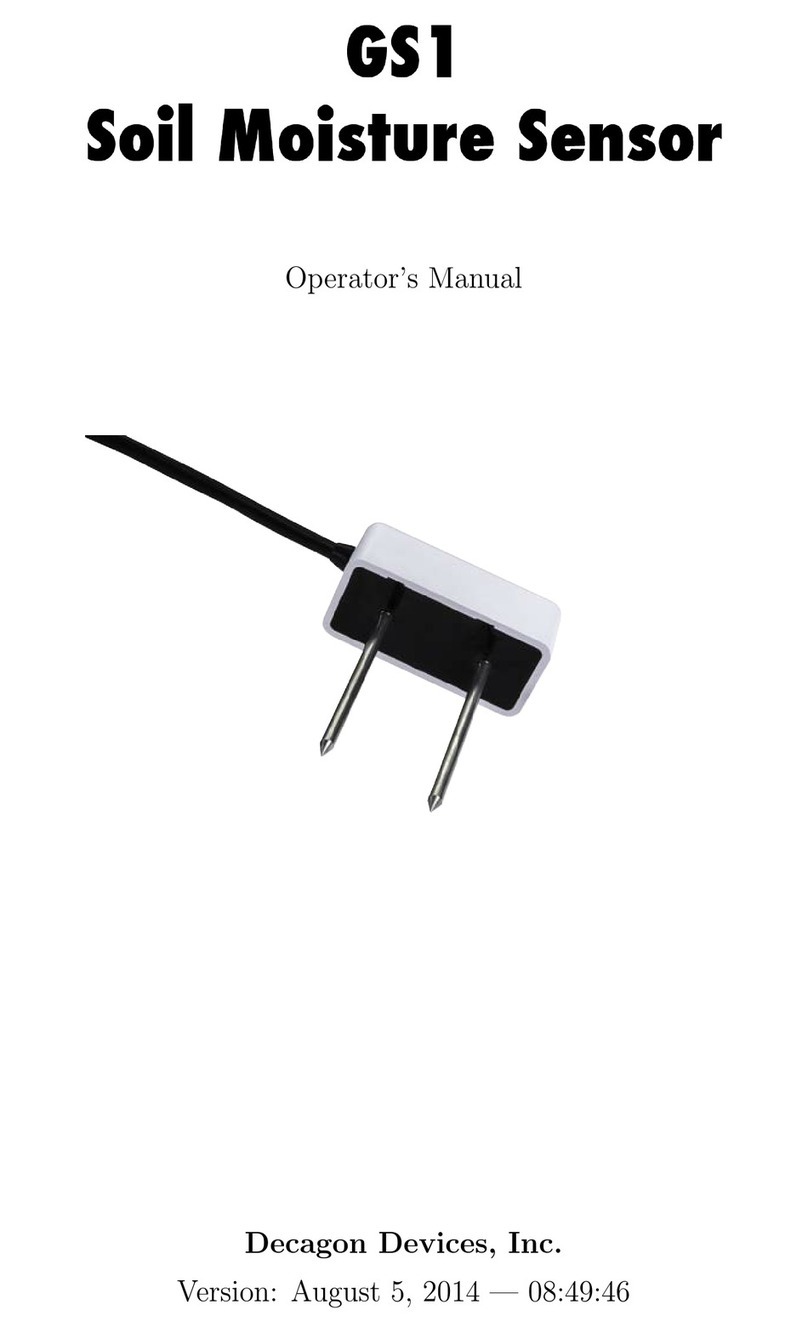
Decagon Devices
Decagon Devices GS1 User manual
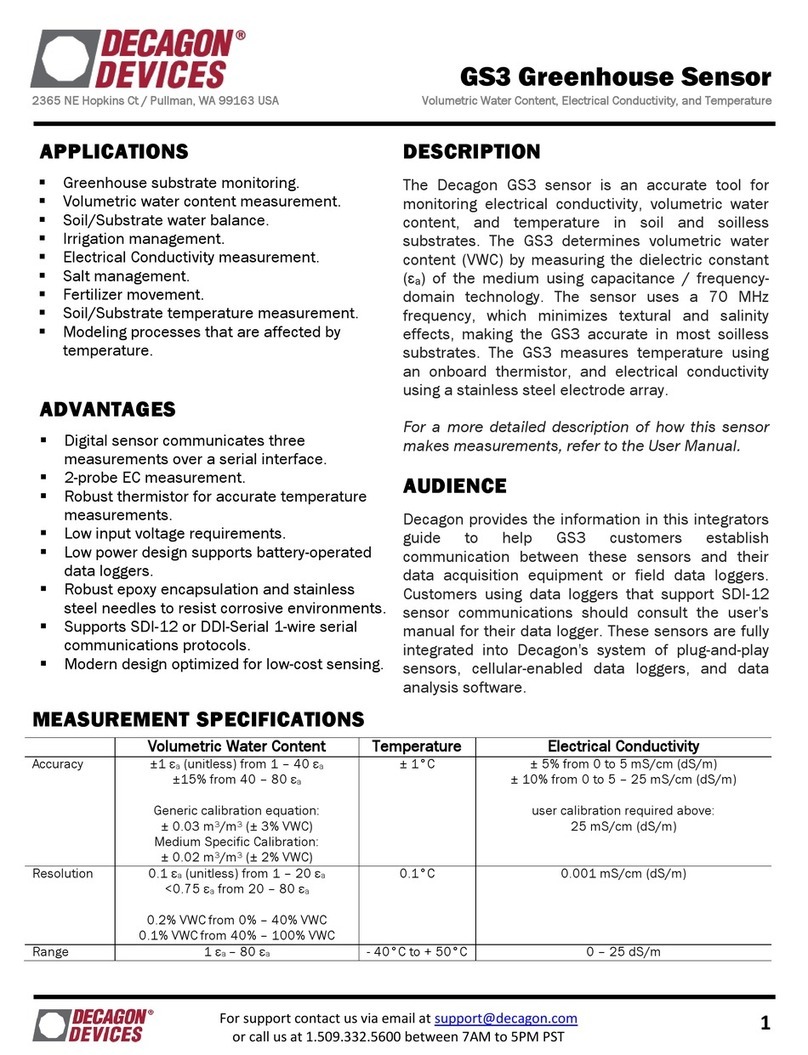
Decagon Devices
Decagon Devices GS3 User manual

Decagon Devices
Decagon Devices 10HS User manual
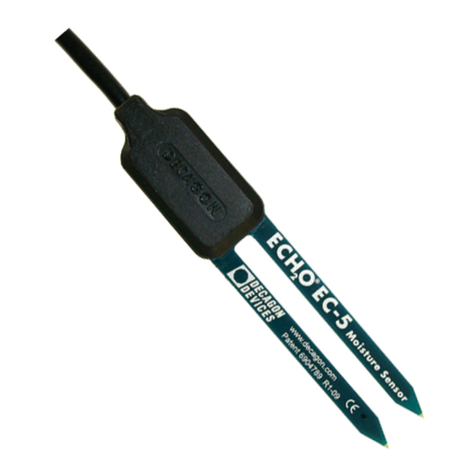
Decagon Devices
Decagon Devices EC-20 User manual
